Let History Never Forget The Name Enterprise
Let History Never Forget the Name Enterprise
Just as the captains of the fictional 24th century Starfleet blazed a trail among the stars, the space shuttle Enterprise helped pave the way for future space exploration.
Fifty years ago, Star Trek debuted with the USS Enterprise as the main space-faring vessel used in much of the Star Trek universe. As such, the vessel holds a treasured place in the hearts of Star Trek fans and is as much of a character in the show as Kirk and Spock. Over three different series and a total of 14 seasons on TV and 13 feature films, the iterations of Enterprise have captured the imaginations and provided inspiration for its fans across the globe.
This brief history of the shuttle tells the tale of humanity’s first reusable spacecraft. Space shuttles were first built in the late 1970s and were flown in space from 1981 to 2011. Their missions ranged from helping to build the International Space Station to repairing the Hubble Space Telescope.
It’s All In The Name

The first shuttle was originally to be named Constitution, celebrating the country’s bicentennial and was to be unveiled to the public on Constitution Day, Sept. 17, 1976. However, a massive letter-writing campaign by Star Trek fans prompted President Gerald Ford to suggest the change. In the above photo, we see the shuttle Enterprise rolled out in Palmdale, California, with cast members of Star Trek on Sept. 17, 1976.
To Boldly Go …

This circular red, white and blue emblem was the official insignia for the Space Shuttle Approach and Landing Test flights and became a model for future space shuttle mission patch designs, including placing the names of the crew on the patch . The four astronauts listed on the patch are:
Fred Haise., commander of the first crew
Charles Fullerton, pilot of the first crew
Joe Engle, commander of the second crew
Dick Truly, pilot of the second crew
First Impressions

In this image, Enterprise makes its first appearance mated to its boosters as it is slowly rolled to the huge Vehicle Assembly Building (VAB) at Kennedy Space Center. Although she never flew in space, shuttle Enterprise underwent a series of fit and function checks on the pad in preparation for the first launch of its sister craft, Columbia.
Not Meant To Be
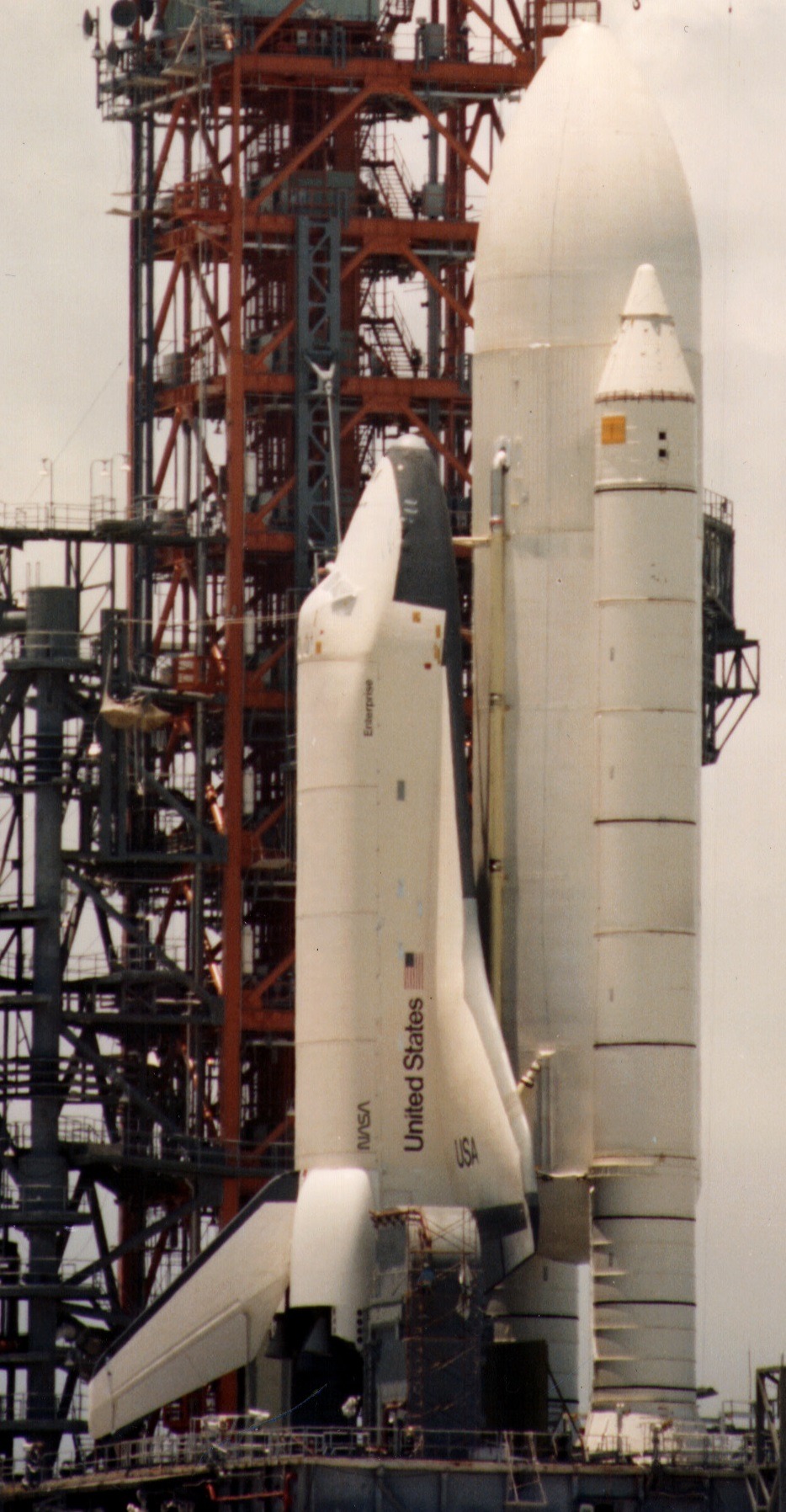
Enterprise sits on Launch Complex 39 at Kennedy Space Center undergoing tests after completing its 3.5 mile journey from the VAB. Have you ever wondered why Enterprise never went into space? Converting Enterprise from a training vehicle to space-worthy one was too cost prohibitive, our engineers felt.
Engage

Commander Fred Haise and pilot Charles Fullerton are seen in the cockpit of Enterprise prior to the fifth and final Approach and Landing Test at Dryden Flight Research Center (Armstrong Flight Research Center). The tests were performed to learn about the landing characteristics of the shuttle.


It’s Been An Honor To Serve With You

The Enterprise’s two crews pose for a photo op at the Rockwell International Space Division’s Orbiter assembly facility at Palmdale, California. They are (left to right) Charles Fullerton, Fred Haise, Joe Engle and Dick Truly.
Fair Winds And Following Seas

On July 6, 2012, the Enterprise, atop a barge, passes the Statue of Liberty on its way to the Intrepid Sea, Air and Space Museum, where is now permanently on display.
Learn more about Star Trek and NASA.
Make sure to follow us on Tumblr for your regular dose of space: http://nasa.tumblr.com
More Posts from Carlosalberthreis and Others

A cidade de Parintins está nos dias de festa religiosa, e então, resolvi relembrar a visita no local mais alto da torre da catedral, onde está localizado a estátua de Nossa Senhora do Carmo. #TorredaCatedraldeParintins Data de registro: 16 de julho de 2018 às 18h18
Travel Posters of Fantastic Excursions
What would the future look like if people were regularly visiting to other planets and moons? These travel posters give a glimpse into that imaginative future. Take a look and choose your destination:
The Grand Tour

Our Voyager mission took advantage of a once-every-175-year alignment of the outer planets for a grand tour of the solar system. The twin spacecraft revealed details about Jupiter, Saturn, Uranus and Neptune – using each planet’s gravity to send them on to the next destination.
Mars

Our Mars Exploration Program seeks to understand whether Mars was, is, or can be a habitable world. This poster imagines a future day when we have achieved our vision of human exploration of the Red Planet and takes a nostalgic look back at the great imagined milestones of Mars exploration that will someday be celebrated as “historic sites.”
Earth

There’s no place like home. Warm, wet and with an atmosphere that’s just right, Earth is the only place we know of with life – and lots of it. Our Earth science missions monitor our home planet and how it’s changing so it can continue to provide a safe haven as we reach deeper into the cosmos.
Venus

The rare science opportunity of planetary transits has long inspired bold voyages to exotic vantage points – journeys such as James Cook’s trek to the South Pacific to watch Venus and Mercury cross the face of the sun in 1769. Spacecraft now allow us the luxury to study these cosmic crossings at times of our choosing from unique locales across our solar system.
Ceres

Ceres is the closest dwarf planet to the sun. It is the largest object in the main asteroid belt between Mars and Jupiter, with an equatorial diameter of about 965 kilometers. After being studied with telescopes for more than two centuries, Ceres became the first dwarf planet to be explored by a spacecraft, when our Dawn probe arrived in orbit in March 2015. Dawn’s ongoing detailed observations are revealing intriguing insights into the nature of this mysterious world of ice and rock.
Jupiter

The Jovian cloudscape boasts the most spectacular light show in the solar system, with northern and southern lights to dazzle even the most jaded space traveler. Jupiter’s auroras are hundreds of times more powerful than Earth’s, and they form a glowing ring around each pole that’s bigger than our home planet.
Enceladus

The discovery of Enceladus’ icy jets and their role in creating Saturn’s E-ring is one of the top findings of the Cassini mission to Saturn. Further Cassini discoveries revealed strong evidence of a global ocean and the first signs of potential hydrothermal activity beyond Earth – making this tiny Saturnian moon one of the leading locations in the search for possible life beyond Earth.
Titan

Frigid and alien, yet similar to our own planet billions of years ago, Saturn’s largest moon, Titan has a thick atmosphere, organic-rich chemistry and surface shaped by rivers and lakes of liquid ethane and methane. Our Cassini orbiter was designed to peer through Titan’s perpetual haze and unravel the mysteries of this planet-like moon.
Europa

Astonishing geology and the potential to host the conditions for simple life making Jupiter’s moon Europa a fascinating destination for future exploration. Beneath its icy surface, Europa is believed to conceal a global ocean of salty liquid water twice the volume of Earth’s oceans. Tugging and flexing from Jupiter’s gravity generates enough heat to keep the ocean from freezing.
You can download free poster size images of these thumbnails here: http://www.jpl.nasa.gov/visions-of-the-future/
Make sure to follow us on Tumblr for your regular dose of space: http://nasa.tumblr.com

High above Saturn
via reddit
Fazer o bem, faz bem!
Banner da Pastoral Social
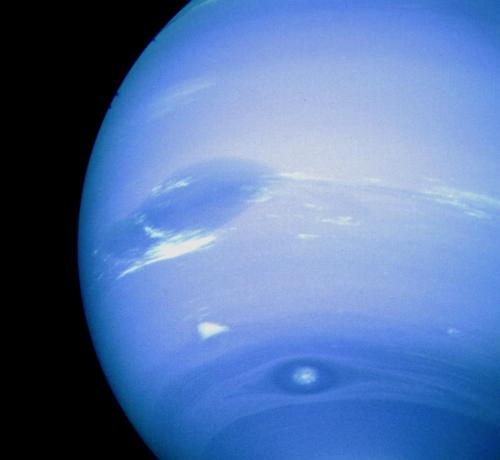
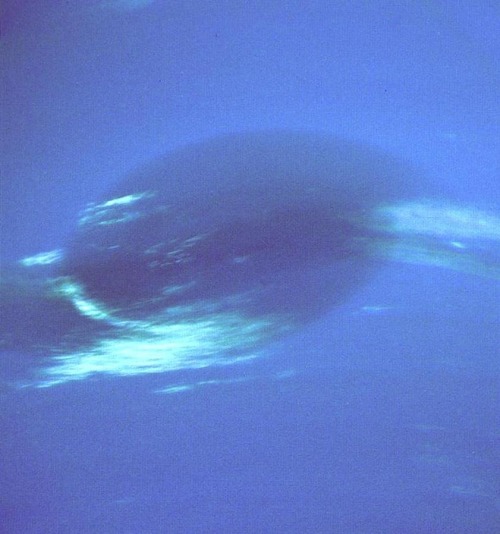
This photograph of Neptune was reconstructed from two images taken by Voyager 2’s narrow-angle camera, through the green and clear filters. At the north (top) is the Great Dark Spot, accompanied by bright, white clouds that undergo rapid changes in appearance.
Credit: NASA
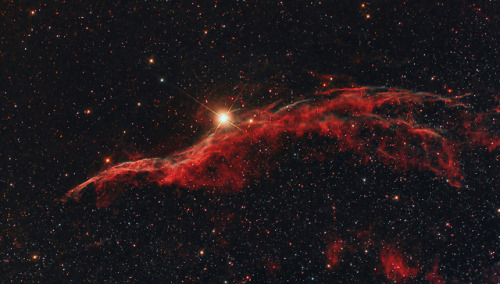
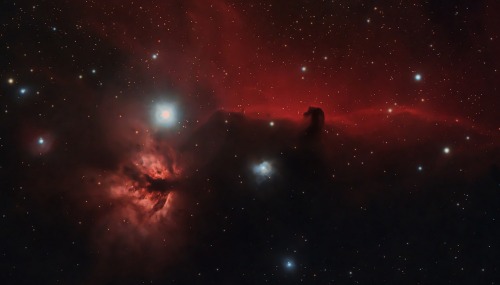
NGC 6960 (Western Veil nebula) & Horsehead Nebula and the Flame Nebula
by David Wills

This is not just an incredible view of Earth, it’s also a fantastic illustration of the terminator. (No not that one!) The terminator is the moving line that separates the day side from the dark night side of a planetary body. From this vantage point you can make out the gradual transition to darkness that is experienced as twilight on the surface. This image was captured on Aug. 31 by astronaut Jeff Williams (@Astro_Jeff) while on board the ISS.
What’s Up - January 2018
What’s Up For January?
Quadrantid meteors, a West Coast-favoring total lunar eclipse and time to start watching Mars!

This month the new year’s first meteor shower fizzles, Mars meets Jupiter in the morning sky and the U.S. will enjoy a total lunar eclipse!

Most meteor showers radiate from recognizable constellations. Like the Leonids, Geminids and Orionids.

But the Quadrantids are meteors that appear to radiate from the location of the former Quadrans Muralis constellation, an area that’s now part of the constellation Bootes.

The Quadrantids’ peak lasts for just a few hours, and sadly, this year their timing coincides with a very bright, nearly full moon that will wash out most of the meteors.

You can look in any direction to see all the meteor showers. When you see one of these meteors, hold a shoestring along the path it followed. The shoestring will lead you back to the constellation containing the meteor’s origin.

On the morning of January 6th, look in the south-southeast sky 45 minutes before sunrise to see Jupiter and fainter Mars almost as close as last month’s Jupiter and Venus close pairing.

Mars is only one-sixth the apparent diameter of Jupiter, but the two offer a great binocular and telescopic view with a pretty color contrast. They remain in each other’s neighborhood from January 5th through the 8th.

Finally, to end the month, a great total lunar eclipse favors the western U.S., Alaska, and Hawaii and British Columbia on January 31st. Australia and the Pacific Ocean are well placed to see a major portion of the eclipse–if not all of it.

Watch the full What’s Up for January Video:
There are so many sights to see in the sky. To stay informed, subscribe to our What’s Up video series on Facebook. Make sure to follow us on Tumblr for your regular dose of space: http://nasa.tumblr.com.

Falta 1 mês pra sonda Juno chegar em Júpiter. Comecei uma série no canal para explicar a missão. O primeiro vídeo já está no ar - https://youtu.be/qjxJ12IB4MQ

Essa imagem capturada pela Wide Field Camera 3, a WFC3 do Hubble, mostra a galáxia chamada UGC 6093. Como se pode ver facilmente, a UGC 6093 é conhecida como uma galáxia espiral barrada - ela tem belos braços que espiralam a partir de uma barra que corta o centro da galáxia. Ela é classificada como uma galáxia ativa, o que significa que ela abriga um núcleo ativo de galáxia, ou um AGN, uma região compacta no centro da galáxia onde o material está centro dragado em direção do buraco negro supermassivo central. À medida que esse buraco negro devora material, ele emite intensa radiação, fazendo com que a galáxia brilhe intensamente. Mas a UGC 6093 é mais exótica ainda. A galáxia age essencialmente como um gigantesco laser astronômico que espalha sua luz nas microondas, não na luz visível, esse tipo de objeto é chamada de megamaser, sendo maser o termo usado para um laser de microondas. Os megamasers como a UGC 6093, podem ser cerca de 100 milhões de vezes mais brilhantes do que os masers encontrados em galáxias como a Via Láctea. A WFC3 do Hubble, observa a luz sendo espalhada em uma grande variedade de comprimentos de ondas, desde o infravermelho próximo, passando pela parte visível, até o ultravioleta próximo. Ela tem dois canais que detectam e processam os tipos diferentes de luz, permitindo que os astrônomos estudem uma grande quantidade de fenômenos astrofísicos, por exemplo, o canal UV-visível pode estudar galáxias que estão passando pelo processo de formação de estrelas, enquanto que o canal do infravermelho próximo pode estudar a luz desviada para o vermelho de galáxias no universo distante. Essas imagens multi-espectrais feitas pelo Hubble são de suma importância para estudar as galáxias megamasers.
-
 macalaelliottphotography liked this · 1 year ago
macalaelliottphotography liked this · 1 year ago -
 credsiocofi liked this · 1 year ago
credsiocofi liked this · 1 year ago -
 ikemenprincessnaga liked this · 2 years ago
ikemenprincessnaga liked this · 2 years ago -
 monroejigsaw reblogged this · 5 years ago
monroejigsaw reblogged this · 5 years ago -
 monroejigsaw liked this · 5 years ago
monroejigsaw liked this · 5 years ago -
 worldinmywindow2 liked this · 5 years ago
worldinmywindow2 liked this · 5 years ago -
 limegreenbabx liked this · 5 years ago
limegreenbabx liked this · 5 years ago -
 elinsmiles liked this · 5 years ago
elinsmiles liked this · 5 years ago -
 kelbasco reblogged this · 6 years ago
kelbasco reblogged this · 6 years ago -
 kelbasco liked this · 6 years ago
kelbasco liked this · 6 years ago -
 fossilsandrelics reblogged this · 6 years ago
fossilsandrelics reblogged this · 6 years ago -
 wemblingfool reblogged this · 6 years ago
wemblingfool reblogged this · 6 years ago -
 commander-ezri reblogged this · 6 years ago
commander-ezri reblogged this · 6 years ago -
 commander-ezri liked this · 6 years ago
commander-ezri liked this · 6 years ago -
 plain-and-simple-ninja liked this · 7 years ago
plain-and-simple-ninja liked this · 7 years ago -
 glynmostyn reblogged this · 7 years ago
glynmostyn reblogged this · 7 years ago -
 alienglidder reblogged this · 7 years ago
alienglidder reblogged this · 7 years ago -
 marie-curie liked this · 7 years ago
marie-curie liked this · 7 years ago -
 fvtsshuttle reblogged this · 7 years ago
fvtsshuttle reblogged this · 7 years ago -
 asukkhati13 liked this · 7 years ago
asukkhati13 liked this · 7 years ago -
 usernamesarebitches reblogged this · 7 years ago
usernamesarebitches reblogged this · 7 years ago -
 usernamesarebitches liked this · 7 years ago
usernamesarebitches liked this · 7 years ago -
 camshaft22 liked this · 7 years ago
camshaft22 liked this · 7 years ago -
 underhill6-blog1 liked this · 7 years ago
underhill6-blog1 liked this · 7 years ago -
 justsomeguypiastri liked this · 7 years ago
justsomeguypiastri liked this · 7 years ago -
 cmjl7811 liked this · 7 years ago
cmjl7811 liked this · 7 years ago
